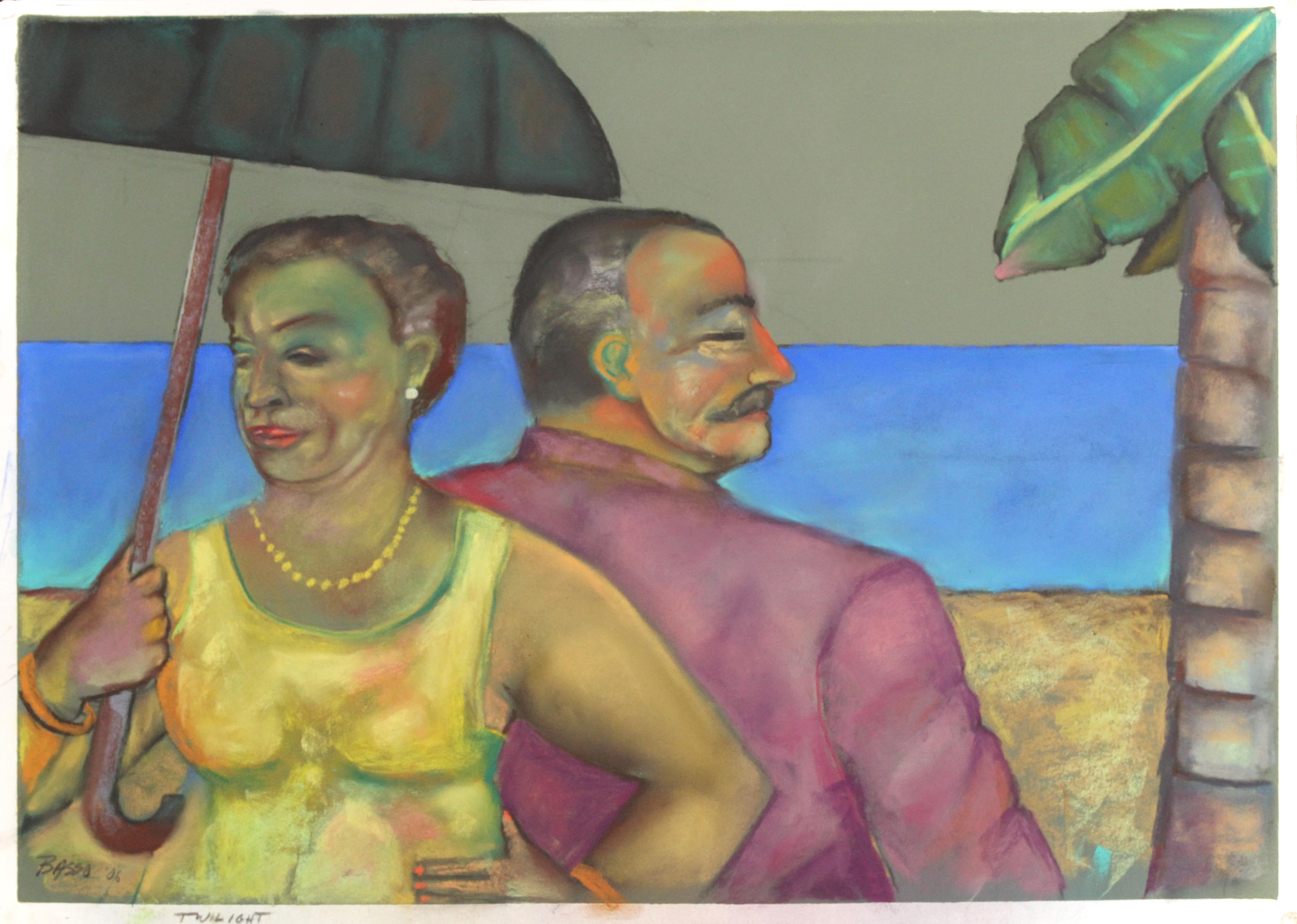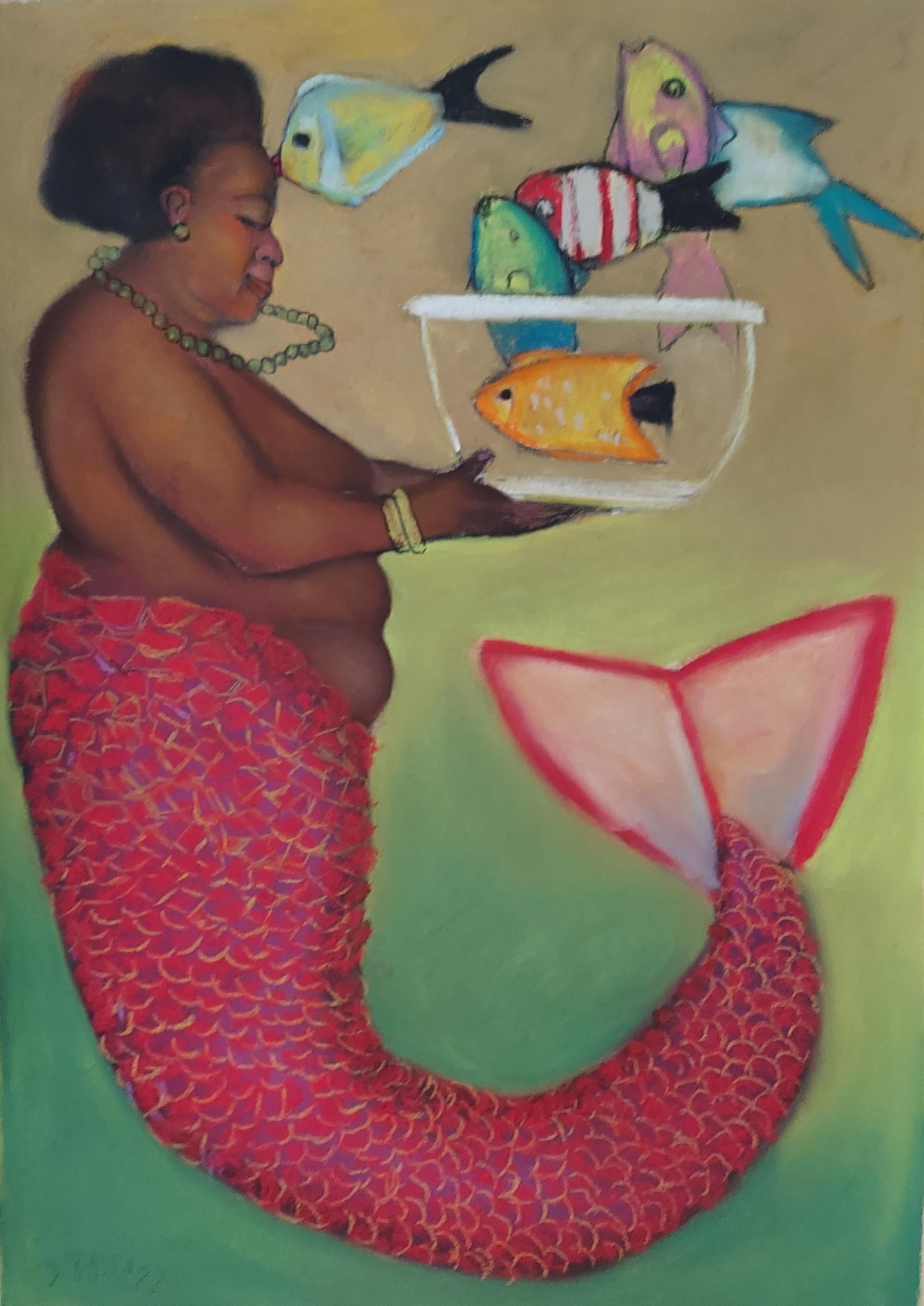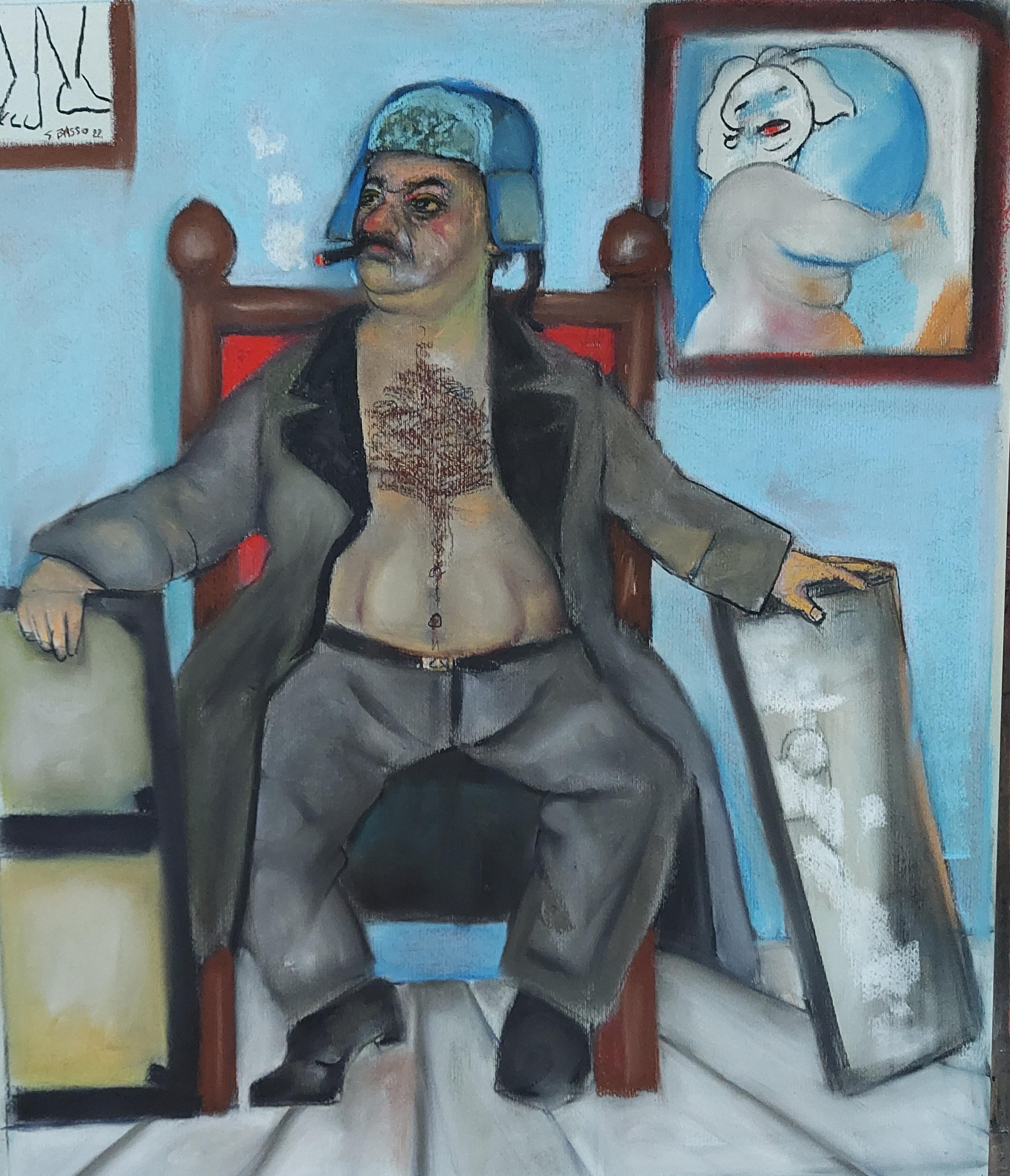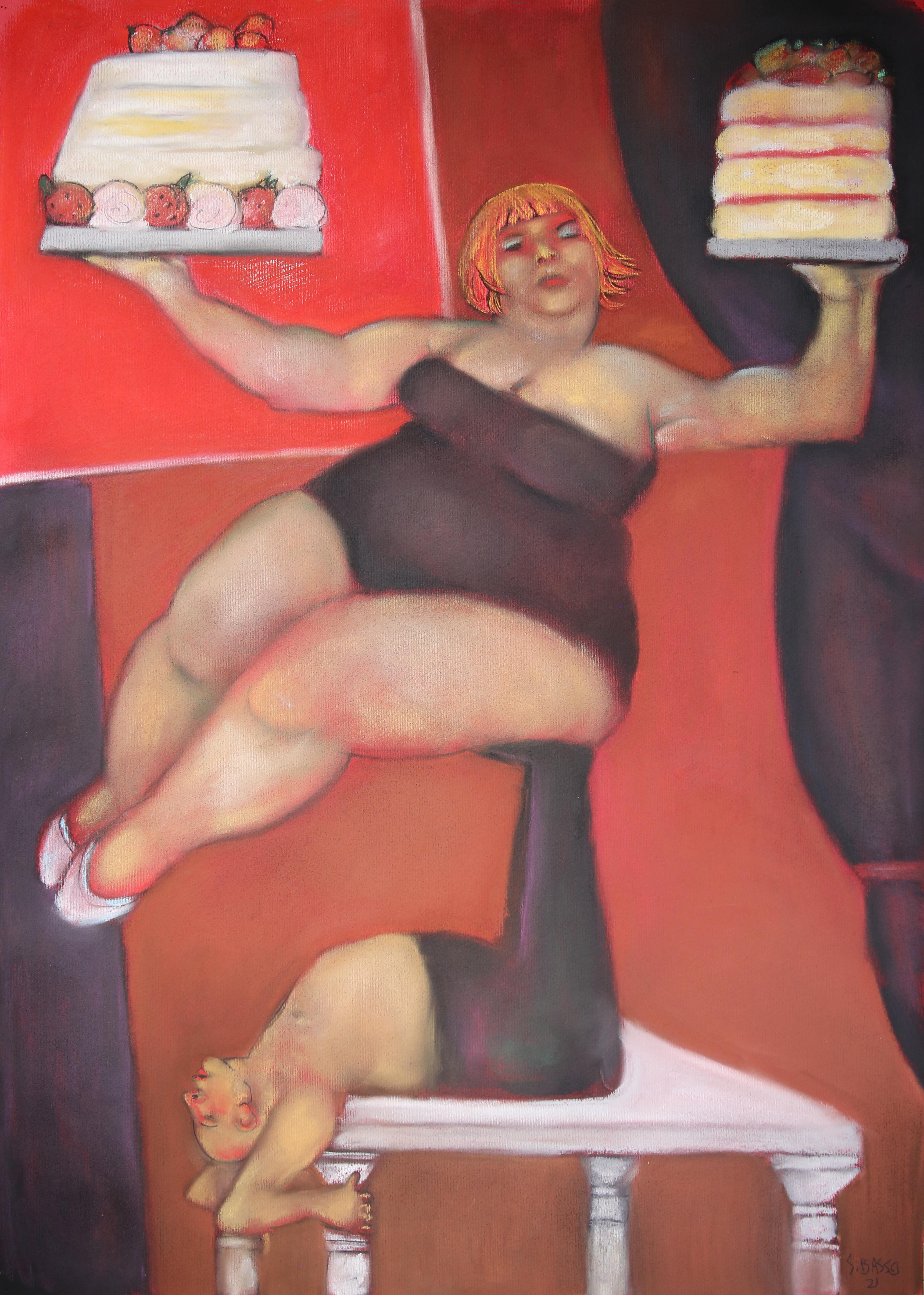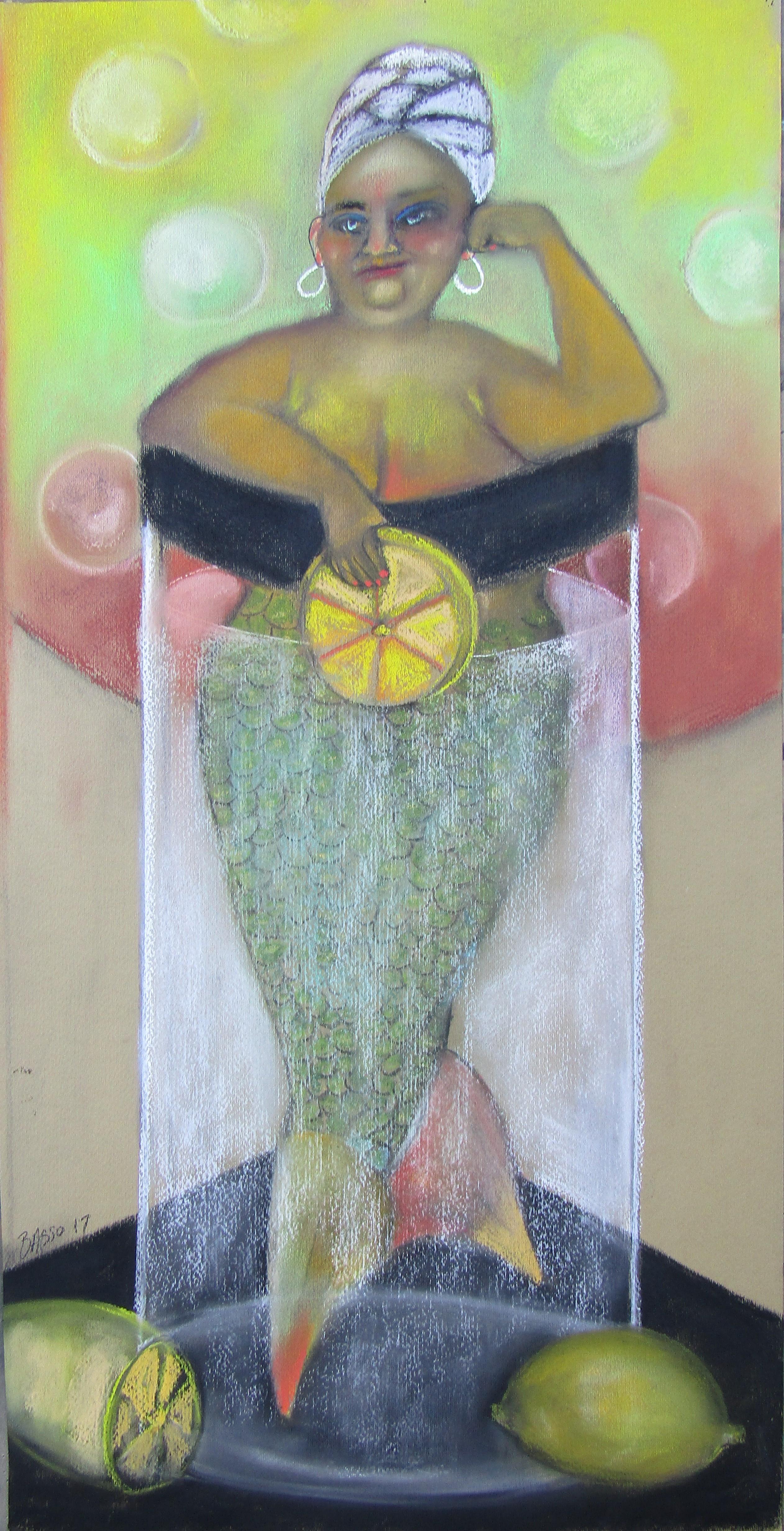Items Similar to the sculptor, charcoal and pastel
Want more images or videos?
Request additional images or videos from the seller
1 of 5
Stephen Bassothe sculptor, charcoal and pastel2018
2018
About the Item
narrative depiction of sculptor at work
Pastel and charcoal on toned paper unframed
*ABOUT Stephen Basso
Stephen Basso's highly original pastels and oil paintings are romantic, yet thought provoking fantasies. His whimsical works are alive with boundless imagination, wry wit and fearless color. His shrewd social observations often translate into eerily humorous figurative scenes and narratives. Mr. Basso’s works evoke a high level of inquiry. The fanciful, yet keenly observed characters are unpredictable and evocative. The viewer vacillates between surprise, delight, and consternation.
A Brooklyn native, much of Basso's wildly imaginative artwork was inspired by travel to Jamaica, Puerto Rico, and especially Mexico. Basso is particularly drawn to Latin American art, channeling its mix of Western and African influences and imagery into his vibrant, often surrealistic work. Combining a New York and a Mexican sensibility, he says of his work, "There is a natural surreal quality to Mexico that can collide with its harsh realities. One might call it bittersweet. It is often bawdy, but rarely vulgar, and images are everywhere. Love, hate, fear desire and of course, humor, never go out of style.” And he adds, " I like mixing high ideals with American irreverence."
The elements of mystery, escapism, and humor blended with reality define his art. It is of a personal nature consisting of a cast of characters that inhabit the stage between the extreme highs and lows of life, a state of limbo where dreamlike scenarios are often pulled back to the reality of daily existence. Of his process, Mr. Basso says, "The paintings and drawings begin with objects around my home and studio, photos from various sources, and people I know, have known, or have yet to meet."
By in large, Basso is self taught. (After initially attending the School of Visual Arts for Illustration, he realized painting was more engaging for him.) Seeking emotional honesty, he looked to the work of several "mentors": Max Beckmann, Francisco Goya, Willem de Kooning , Philip Guston , Marsden Hartley and Albert Pinkham Ryder - artists that spoke to the human condition
- Creator:Stephen Basso (1953, American)
- Creation Year:2018
- Dimensions:Height: 27.01 in (68.6 cm)Width: 19.02 in (48.3 cm)Depth: 0.99 in (2.5 cm)
- Medium:
- Movement & Style:
- Period:
- Condition:
- Gallery Location:Brooklyn, NY
- Reference Number:1stDibs: LU133915703421
Stephen Basso
Stephen Basso's highly original pastels and oil paintings are romantic yet thought provoking fables. His whimsical works are alive with boundless imagination wry wit and fearless color. Mr. Basso's works evoke a high level of inquiry. The fanciful yet keenly observed characters are unpredictable and evocative. The viewer vacillates between surprised delight and consternation, A Brooklyn native much of Basso's art has been inspired by travel to Jamaica Puerto Rico and in particular Mexico blended with is urban New York experience.
By in large Basso is self taught ( after initially attending the School of Visual Arts for illustration he came to the conclusion painting was more engaging ) Seeking emotional honesty he has looked to the work of several mentors notably Max Beckmann Willem de Kooning Goya Marsden Hartley and Albert Pinkham Ryder to name a few...artists that speak to the human condition
About the Seller
5.0
Vetted Seller
These experienced sellers undergo a comprehensive evaluation by our team of in-house experts.
Established in 2005
1stDibs seller since 2020
84 sales on 1stDibs
Typical response time: 2 hours
- ShippingRetrieving quote...Ships From: Brooklyn, NY
- Return PolicyA return for this item may be initiated within 7 days of delivery.
More From This SellerView All
- Twilight narrative pastel painting bright color beach scene couplesBy Stephen BassoLocated in Brooklyn, NYsoft pastel on toned paper . This work is mounted on archival foam board with clear plastic to protect surface. Framing under glass is recommended *ABOUT Stephen Basso Stephen Basso...Category
2010s Expressionist Drawings and Watercolor Paintings
MaterialsPastel, Archival Paper
- Carousel humorous dreamlike narrative story expressive human condition greysBy Stephen BassoLocated in Brooklyn, NYSoft pastel and charcoal on toned archival toned paper signed and dated bottom left . On view at the table Rasa Gallery in Brooklyn NY.Category
2010s Expressionist Figurative Drawings and Watercolors
MaterialsPastel, Archival Paper
- Caribbean Mermaid soft tropical color Mermaid and angel fish mythical subjectBy Stephen BassoLocated in Brooklyn, NYSoft pastel on toned sanded archival paper suitable for framing under glass. Signed and dated bottom. Part of an ongoing series of mermaids by the artistCategory
2010s Expressionist Figurative Drawings and Watercolors
MaterialsPastel, Archival Paper
- Blue Period artist as subject humorous observation coll blue and Grey tonesBy Stephen BassoLocated in Brooklyn, NYSoft pastel on archival toned paper signed and dated top left. Part of an ongoing series by the artist of artist and model subject matterCategory
2010s Expressionist Figurative Drawings and Watercolors
MaterialsArchival Paper, Pastel
- Buttercream Acrobats circus performers humorous subject male female dynamicBy Stephen BassoLocated in Brooklyn, NYthis is a soft pastel on red toned heavyweight archival paper , framing under glass recommended for display. full figured women like Botero theme: circus, food, cake, relationships,...Category
2010s Expressionist Figurative Drawings and Watercolors
MaterialsPastel, Archival Paper
- Mermaid &Tonic mythical sea creatures humor soft light colorBy Stephen BassoLocated in Brooklyn, NYPart of an ongoing series of mermaids by the artist on toned archival paper signed and dated on bottomCategory
2010s Expressionist Figurative Drawings and Watercolors
MaterialsArchival Paper, Pastel
You May Also Like
- Hula Study, energetic realistic charcoal drawing on paper, girl and hula hoopBy Patsy McArthurLocated in Dallas, TX"Hula Study" is an energetic and unique charcoal on paper by Patsy McArthur showing a female figure dancing with a hula hoop. It is created using charcoal and pastel on pale pink Mur...Category
2010s Realist Figurative Drawings and Watercolors
MaterialsArchival Paper, Handmade Paper, Charcoal, Pastel
- Rooftops (Framed 1970's New York Cityscape Landscape Drawing by William Clutz)By William ClutzLocated in Hudson, NYAbstracted New York City landscape drawing of urban rooftops and tree tops "Rooftops", created by William Clutz in 1977 30 x 20 inches, charcoal and pastel on paper 33 x 25 inches in light wood frame This framed pastel on paper was made in 1977 by William Clutz. It features an abstracted depiction of New York City rooftops as seen from a high window. Of particular note is the artist's technique with pastel; a wonderful texture and motion is created by closely woven striated lines. Sunlight reflects off brown rooftops and peaking green tree tops. The charcoal and pastel drawing is framed in a natural light wood frame with non-reflective glass and wire backing for installation. About the Artist: Renowned as the “impressionist of the contemporary metropolis”, William Clutz uses the city, in its entirety, as his subject. Pedestrians crossing streets become stars of the stage; the hustle and bustle of traffic and surrounding buildings are the chorus; each play their part in the overall composition. Lighting and color shift this observation of the everyday into a remarkable wonder. “It is surely Clutz”, wrote Gerrit Henry in Art News, 1979, “an artist who has rejected the niceties of representation in favor of the quintessence.” The young artist moved to New York City in 1955 and just four years later had his first solo exhibit at the Condon Riley Gallery. Clutz went on to show in major uptown galleries such as David Herbert, where, notably in 1962 he received a NYTimes review titled, Return of the Figure. That same year, his role in the revival of figuration was further solidified with inclusion in the MoMA group show, Recent Painting USA, The Figure. This was a pivotal turning point from which emerged a 50-year exhibiting career. Resume Born: Gettysburg, PA 1933 Mercersburg, PA 1933-1951 New York City 1955-1996 Education Painting: Thomas Danaher(WPA artist) 1944-51 Mercersburg Academy, PA 1947...Category
1970s Modern Landscape Drawings and Watercolors
MaterialsPastel, Charcoal, Archival Paper
- Expressionist Ink, Pastel, Crayon Drawing Jewish American Modernist Ben Zion WPABy Ben-Zion WeinmanLocated in Surfside, FLExpressionist ink and pastel crayon drawing of beans (carobs, flowers?) in pods Hand signed. Born in 1897, Ben-Zion Weinman celebrated his European Jewish heritage in his visual works as a sculptor, painter, and printmaker. Influenced by Spinoza, Knut Hamsun, and Wladyslaw Reymont, as well as Hebrew literature, Ben-Zion wrote poetry and essays that, like his visual work, attempt to reveal the deep “connection between man and the divine, and between man and earth.” An emigrant from the Ukraine, he came to the US in 1920. He wrote fairy tales and poems in Hebrew under the name Benzion Weinman, but when he began painting he dropped his last name and hyphenated his first, saying an artist needed only one name. Ben-Zion was a founding member of “The Ten: An Independent Group” The Ten” a 1930’s avant-garde group, Painted on anything handy. Ben-Zion often used cabinet doors (panels) in his work. Other members of group included Ilya Bolotowsky, Lee Gatch, Adolph Gottlieb, Louis Harris, Yankel Kufeld, Marcus Rothkowitz (later known as Mark Rothko), Louis Schanker, and Joseph Solman. The Art of “The Ten” was generally described as expressionist, as this style offered the best link between modernism and social art. Their exhibition at the Mercury Gallery in New York held at the same time as the Whitney Annual Exhibition of Contemporary American Painting, included a manifesto concentrating on aesthetic questions and criticisms of the conservative definition of modern art imposed by the Whitney. Ben-Zion’s work was quickly noticed. The New York Sun said he painted “furiously” and called him “the farthest along of the lot.” And the triptych, “The Glory of War,” was described by Art News as “resounding.” By 1939, The Ten disbanded because most of the members found individual galleries to represent their work. Ben-Zion had his first one-man show at the Artist’s Gallery in Greenwich Village and J.B. Neumann, the highly esteemed European art dealer who introduced Paul Klee, (among others) to America, purchased several of Ben-Zion’s drawings. Curt Valentin, another well-known dealer, exhibited groups of his drawings and undertook the printing of four portfolios of etchings, each composed of Ben-Zion’s biblical themes. He worked as a WPA artist. Ben-Zion’s work is represented in many museums throughout the country including the Metropolitan, the Whitney, and the Museum of Modern Art in New York, the Art Institute of Chicago, the Philadelphia Museum of Art and the Phillips Collection, Washington. The Jewish Museum in New York opened in 1948 with a Ben-Zion exhibition. Ben-Zion consistently threaded certain subject matter—nature, still life, the human figure, the Hebrew Bible, and the Jewish people—into his work throughout his life. "In all his work a profound human feeling remains. Sea and sky, even sheaves of wheat acquire a monolithic beauty and simplicity which delineates the transient as a reflection of the eternal. This sensitive inter- mingling of the physical and metaphysical is one of the most enduring features of Ben-Zion's works." (Excerpt from Stephen Kayser, “Biblical Paintings,” The Jewish Museum Catalogue, 1952). Mystical Imprints: Marc Chagall, Ben-Zion, and Ben Shahn presents the print work of three prominent 20th century Jewish artists born in the Russian Empire. Among these seventy pieces are etchings and lithographs from Chagall’s Bible series...Category
Mid-20th Century Expressionist Still-life Drawings and Watercolors
MaterialsPaper, Oil Crayon, Pastel, Ink
- Expressionist Color Drawing Cobalt Glass Vintage Frame Modernist Ben Zion WPABy Ben-Zion WeinmanLocated in Surfside, FLExpressionist ink and pastel crayon drawing of flowers in vase. Framed in a vintage cobalt blue glass original frame Hand signed and dated Framed it measures 13.5 X 10.5 The actual paper is 7.5 X 5.5 Born in 1897, Ben-Zion Weinman celebrated his European Jewish heritage in his visual works as a sculptor, painter, and printmaker. Influenced by Spinoza, Knut Hamsun, and Wladyslaw Reymont, as well as Hebrew literature, Ben-Zion wrote poetry and essays that, like his visual work, attempt to reveal the deep “connection between man and the divine, and between man and earth.” An emigrant from the Ukraine, he came to the US in 1920. He wrote fairy tales and poems in Hebrew under the name Benzion Weinman, but when he began painting he dropped his last name and hyphenated his first, saying an artist needed only one name. Ben-Zion was a founding member of “The Ten: An Independent Group” The Ten” a 1930’s avant-garde group, Painted on anything handy. Ben-Zion often used cabinet doors (panels) in his work. Other members of group included Ilya Bolotowsky, Lee Gatch, Adolph Gottlieb, Louis Harris, Yankel Kufeld, Marcus Rothkowitz (later known as Mark Rothko), Louis Schanker, and Joseph Solman. The Art of “The Ten” was generally described as expressionist, as this style offered the best link between modernism and social art. Their exhibition at the Mercury Gallery in New York held at the same time as the Whitney Annual Exhibition of Contemporary American Painting, included a manifesto concentrating on aesthetic questions and criticisms of the conservative definition of modern art imposed by the Whitney. Ben-Zion’s work was quickly noticed. The New York Sun said he painted “furiously” and called him “the farthest along of the lot.” And the triptych, “The Glory of War,” was described by Art News as “resounding.” By 1939, The Ten disbanded because most of the members found individual galleries to represent their work. Ben-Zion had his first one-man show at the Artist’s Gallery in Greenwich Village and J.B. Neumann, the highly esteemed European art dealer who introduced Paul Klee, (among others) to America, purchased several of Ben-Zion’s drawings. Curt Valentin, another well-known dealer, exhibited groups of his drawings and undertook the printing of four portfolios of etchings, each composed of Ben-Zion’s biblical themes. He worked as a WPA artist. Ben-Zion’s work is represented in many museums throughout the country including the Metropolitan, the Whitney, and the Museum of Modern Art in New York, the Art Institute of Chicago, the Philadelphia Museum of Art and the Phillips Collection, Washington. The Jewish Museum in New York opened in 1948 with a Ben-Zion exhibition. Ben-Zion consistently threaded certain subject matter—nature, still life, the human figure, the Hebrew Bible, and the Jewish people—into his work throughout his life. "In all his work a profound human feeling remains. Sea and sky, even sheaves of wheat acquire a monolithic beauty and simplicity which delineates the transient as a reflection of the eternal. This sensitive inter- mingling of the physical and metaphysical is one of the most enduring features of Ben-Zion's works." (Excerpt from Stephen Kayser, “Biblical Paintings,” The Jewish Museum Catalogue, 1952). Mystical Imprints: Marc Chagall, Ben-Zion, and Ben Shahn presents the print work of three prominent 20th century Jewish artists born in the Russian Empire. Among these seventy pieces are etchings and lithographs from Chagall’s Bible series...Category
1950s Expressionist Still-life Drawings and Watercolors
MaterialsPaper, Oil Crayon, Pastel, Ink
- The Final StretchBy Maurice EMPILocated in London, GB'The Final Stretch', pastel on weighted art paper, by Maurice Empi (circa 1980s). One can almost feel the excitement of the horse race from this exuberant and colourful work of art. ...Category
1980s Expressionist Animal Drawings and Watercolors
MaterialsPaper, Pastel
- The owner II - Parmis Sayous 21st Century drawing, Iranian contemporary painterBy Parmis SayousLocated in Paris, FRPastel on paper Created in 2018 in Paris, France Unique work Signed by the artistCategory
2010s Expressionist Figurative Drawings and Watercolors
MaterialsPastel, Paper
Recently Viewed
View AllMore Ways To Browse
Pastel Artwork
Mexican Sculptor
Pastel Oil Large
Charcoal Gray Large Painting
Love Hate
Albert Pastel
Whimsical Art On Pastels
Mr Imagination
Albert Willem
African American Charcoal
Albert Pinkham Ryder
Sylvias Antiques
T Samson Paintings
Vietnamese Watercolor Paintings
Bulgaria Watch
Cinco Pintores
Drawings Of Colonial India
Enigma Watch
